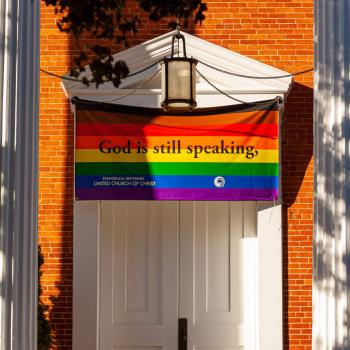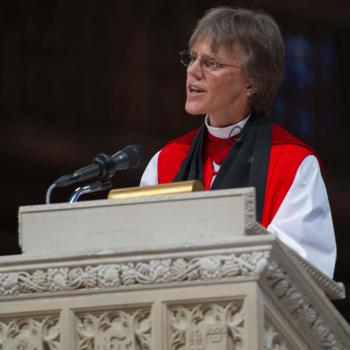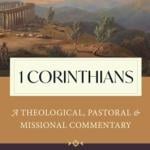In this series I am looking at the act of deconstruction and juxtaposing it against a constructive view of humanity. The constructive view of humanity I am proposing is a theological view of human persons. It is seeing human persons in light of their Divine Creator: the One who puts the theos in theology.
A Word About Theology in Context
This theological view of what it means to be a human person is by no means novel. In fact I scorn novelty, as should we all. At least, we should scorn novelty for novelty’s sake. But hating novelty is already a position that stands in glaring contrast to the current spirit of the age and radical deconstruction. Nevertheless, any worthwhile view has its historical predecessors and a time-worn tradition. This counts for deconstruction theories just as much as any other. There are few true nihilists in the world, and, if there are such nihilists, what exactly would they write about and why?
The best “new” theology, therefore, is always a re-articulation of the old, just in the context of new or dynamic circumstances. It may be true what the classicist Julius Hare wrote in his 1867 Guesses at Truth, that
Goethe in 1800 does not write just as Shakespeare wrote in 1600: but neither would Shakespeare in 1800 have written just as he wrote in 1600. For the frame and aspect of society are different; the world which would act on him, and on which he would have to act, is another world.
Julius Hare, Guesses at Truth, quoted in Stephen Prickett “An Ache in the Missing Limb: Biblical Origins of English Literary Criticism” (40).
Nevertheless, that Shakespeare would have written differently in a different (later) cultural context, does not mean that what he wrote in 1600 is not as valid or as true as it was in 1800. It only means he might have had to express those same truths differently had he lived in 1800. He might have had to amend his poetic form and the frame of his works but not the inherent meaning of the sentences he penned. And so it is with any theological writing as well. Chasing novelty is for the foolish, the arrogant or the dumb.
Deconstruction Revisited
I argue, therefore, that the process of deconstruction is itself not only a universal human act but an act that ultimately points to other truths about all humans. These other truths are, in turn, not deconstructable. If you like, they are indestructible. This does not mean that we always are aware of these truths. Nor does it mean we cannot suppress them and pretend they are not the truth. It only means that, in virtue of being true, they are unchangeable over time and apply universally regardless of cultural differences.
Deconstruction, therefore, need not be an infinite regress of interpretations that never lands anywhere. It is not an endless process of asking “yeah, but who says?” Unless, of course, one desires it to be so. Instead, deconstructing narratives opens us up to fixed and foundational truths that those narratives agree on or point to. We can all recognize these foundations if we approach the process of deconstruction with wisdom and humility. The first foundational truth to acknowledge before considering some concrete examples of our shared humanity is human identity itself.
This article discusses how both the modern, scientific view and the post-modern, social view of identity, while helpful, ultimately do not grasp the true mystery and inherent value of human identity. Instead, it is a pre-modern, ontological status that grounds the irreducible mystery and innate value of human identity. That status is the metaphysical fact that all humans being are made in the image of a Creator.
The Modern Narrative: The Scientific Story
In C.S. Lewis’ classic tale of conversion, The Pilgrim’s Regress, one of the characters, young Mr. Enlightenment (conceived of as Freud), throws the hero John into a pit dug into the side of a mountain. A giant, The Spirit of the Age, lives on the mountaintop and his gaze penetrates through the very flesh of the prisoners trapped in the cavernous prison:
John lay in his fetters all night in the cold and stench of the dungeon. And when morning came there was a little light at the grating, and, looking round, John saw that he had many fellow prisoners, of all sexes and ages. But instead of speaking to him, they all huddled away from the light and drew as far back into the pit, away from the grating, as they could. But John thought that if he could breathe a little fresh air he would be better, and he crawled up to the grating. But as soon as he looked out and saw the giant, it crushed the heart out of him: and even as he looked, the giant began to open his eyes and John, without knowing why he did it, shrank from the grating.Now I dreamed that the giant’s eyes had this property, that whatever they looked on became transparent. Consequently, when John looked round into the dungeon, he retreated from his fellow prisoners in terror, for the place seemed to be thronged with demons. A woman was seated near him, but he did not know it was a woman, because, through the face, he saw the skull and through that the brains and the passages of the nose, and the larynx, and the saliva moving in the glands and the blood in the veins: and lower down the lungs panting like sponges, and the liver, and the intestines like a coil of snakes. And when he averted his eyes from her they fell on an old man, and this was worse for the old man had a cancer. And when John sat down and drooped his head, not to see the horrors, he saw only the working of his own inwards.
C.S. Lewis, The Pilgrim’s Regress
In this passage Lewis describes with unparalleled imagery what philosophers might call the 3rd-person perspective of the human person. Science, in impersonal objectivity, sees man only as an organism, a biological entity reducible to its basic, anatomical parts. Man is DNA and impersonal matter. People are mere molecules in motion. The Spirit of the Age in the story of John is Modernism. More particularly, it is the Scientism which was birthed out of the Enlightenment, which crowned Reason as the sole source of knowledge.
This Scientism reached its pinnacle in the 1940’s and 50’s with the mature thought of the logical positivists, whose famous maxim stated what could not be verified by scientific investigation was essentially meaningless. Man is, or was, the sum total of his biological parts. These parts could be exhaustively described in a scientific idiom. Beyond that there was nothing more to say, no other story to tell. This is the 3rd-person perspective. What we can speak of in 3rd-person terms is all we can say of anything and is the only thing that counts as truth. Joe and Jane’s humanity is fully exhausted once we have exhaustively described their physical parts: their height, weight, hair color, bone structure, etc. There is no “I” there to speak of, only an “it.”
What went on inside a man’s “soul,” the first-person perspective of conscious life, the stuff of human experience, is at most an epiphenomena of the raw matter of a highly evolved brain. Brains just churn out things like moral sensibilities, longings, desires and feelings of transcendence. Scientific analysis could ultimately explain away all of these deep features of humanity. Or so the story went.
There are very few hard core modernists left. Logical Positivism eventually collapsed under the weight of its own criteria. Further, the new existentialism of the 20th century, the emerging global cry for social justice and even the dawn of the New Age religions all mitigated against Scientism’s notion that man can be reduced to the totality of his physical parts. By the time new atheists like Richard Dawkins or Christopher Hitchens tried to popularize what men like Ayers, Feigl and Schlick had done in the academy a generation before, the intellectual ground had already shifted under their feet. As such, their reign was quite short.
No, we are more than biological machines, even if we are very sophisticated ones at that. Perhaps, instead, we are more like social constructs, projects and products of the cultures in which we reside.
The Post-Modern Narrative: The Story of Social Theory
Critical theorists skeptical of the scientistic view of human persons turned toward social identity and our first-person experience of that identity as the hallmark of human personhood. Karl Marx, for example, saw all of human history through this lens of socially constructed identity groups, groups pitted against each other in a progressive battle over power, wealth and privilege. The question before us then is whether this view of humanity or human personhood is better than its predecessor and whether it suffices to explain who or what we are.
On this social identity view, social location determines what one is. By “social location,” I mean what most critical theorists mean, the construction of a personal or group identity based upon certain social features and conditions in which an individual body resides. These would be features like race, economic class, gender, religious affiliation, etc. None of these features are themselves substantive, they too are just constructed realities. Thus, when critical theorists refer to human persons apart from their socially constructed features, they often refer to them simply as “bodies.” People are socialized bodies.
For many social theorists, who are atheists or agnostics about religious or metaphysical claims, human identity just is what the individual can be reduced to socially. That socially constructed identity may be partially chosen, but is also, in part, imposed upon particular bodies. As Julius Hare pointed out in 1867, the world acts on the person as the person acts on the world in which he resides. For critical theorists this interplay does not just affect the aesthetic production of the artist, it makes or creates the artist herself.
Supreme Court Justice, Sonia Sotomayor implied this social view of identity in a 2001 speech at the University of California, Berkeley:
Many of us struggle with this tension and attempt to maintain and promote our cultural and ethnic identities in a society that is often ambivalent about how to deal with its differences. In this time of great debate we must remember that it is not political struggles that create a Latino or Latina identity. I became a Latina by the way I love and the way I live my life. My family showed me by their example how wonderful and vibrant life is and how wonderful and magical it is to have a Latina soul.
Here, Sotomayor affirms that identity is both imposed upon her by an external entity (fortunately for her a loving family) while also being freely chosen. Her choice to love and live a certain way is what determines her being Latina.
In a seminal article on anti-essentialism in Feminist theory, legal scholar Angela Harris also describes this sense of the individual human body as a amalgam of vying social features:
It is a premise of this article that we are not born with a “self,” but rather are composed of a welter of partial, sometimes contradictory, or even antithetical “selves.” A unified identity, if such can ever exist, is a product of will, not a common destiny or natural birthright. Thus, consciousness is “never fixed, never attained once and for all”; it is not a final outcome or a biological given, but a process, a constant contradictory state of becoming, in which both social institutions and individual wills are deeply implicated.
Angela P. Harris, “Race and Essentialism in Feminist Legal Theory”
Harris points out the continuous battle of some thing, we know not what, wrestling to have a unified identity. That unified identity, if it can ever be realized, must be chosen. It is an act of the will that determines identity, but it is a will that exists within social institutions. Sartre captured the first part succinctly as, “Existence before essence.”
Finally, Duncan Kennedy, considering the nature of personhood and group identity in his article on affirmative action, affirms the underlying hermeneutic that Sotomayor and Harris presuppose:
We need to be able to talk about the political and cultural relations of various groups that compose our society without falling into racialism, essentialism, or a concept of the “nation” tied to the idea of sovereignty. We need to conceptualize groups in a “post-modern” way, recognizing their reality in our lives without losing sight of the partial, unstable, contradictory character of group existence.
Duncan Kennedy, “A Cultural Pluralist Case for Affirmative Action in Legal Academia” [emphasis added]
In short, to understand identity (individual or group) in the “post-modern way” is to presuppose that there is nothing about human nature that is fixed and universal. There is nothing that essentially binds us together or that transcends our socially constructed identities. It is to say there is nothing about us that endures diachronically (over time) or that we can affirm today synchronically (across cultures at a given time).
True, we might transcend the biological view of the person that the Enlightenment foisted upon us, but the stopping point of that transcendence is just what we are socially. The 1st-person perspective, either in the singular “I” or the plural “We,” may grant us something more valuable than the impersonal 3rd-person perspective. Minimally, it gives us our personal experiences back as meaningful. However, we could easily see the problems with the social-construct view of human identity if we simply replaced in Lewis’ analogy of the Spirit of the Age, a post-modernist giant for the modernist one. Instead of the giant making the skin of his captives translucent and showing them as nothing more than anatomical parts, he shows them to be mere products of their surrounding and quite incomplete and confused products at that.
Human Identity: Neither Scientistic Nor Social
While it may be true that social location hinders us from seeing that which is essential and universal (in fact, it most certainly does), that does not entail that there is nothing essential and universal to be seen. The post-modern way of thinking about persons and their societies makes finding a “way forward” almost entirely arbitrary. This arbitrary attempt to move society forward, to “progress,” is grounded in an irrational impulse. It is an irrational impulse that has consumed the popular culture for too long now. It is an impulse that must be stopped or, at least, its energies diverted to something more constructive than destructive.
Further, if there are fundamental truths that apply to all people, we might expect to see and even feel things in common. Likely, if we all shared the same or similar feelings about some things, then that commonality would be regardless of our social location. That such experiences, attitudes and dispositions are common across societies, provides evidence that something about humanity preexists the socialization of our human bodies. In the posts that follow I will provide concrete examples of common human features which suggest we are not just socially constructed beings.
Finally, we should not overlook the incoherence of at least one aspect of such claims about identity being socially constructed. For example, in Angela Harris’ view about the self, it seems rather obvious that she has not seriously considered what it is that actually performs the very acts of choosing and organizing a social identity. Indeed, what else could carry out such an operation, other than a substantive self which is itself not a product of society or its impositions?
As to the scientistic view of the self, the post-modern critique is still valid in spite of its own flaws. We know we are at least more than the sum total of our biological parts. One does not need to even argue this given the rich and complex inner workings of the human person. Moreover, even if some Christian philosophers have tried to wed consciousness to the notion that we are only physical things, the expanding and staggering empirical evidence for the existence of an immaterial soul should suffice to convince any brain that the scientistic, materialistic and impersonal view of the human person is, to say the least, quite unscientific.
The Pre-Modern Alternative: Identity as Sacred
As I hope to show in this series, while there is truth in the views of both the scientist and the social theorist, those views are obviously deficient in critical ways. For one, all people have at least one feature that is not based on any social or even biological given. This is their status as image bearer of God or “divinely created creature” (for those who brace at the idea of a personal God). But this identity is an ontological status. It is an identity that no biological deficiency or social stigma can or ever could touch upon, alter or amend. One cannot lose this status as one might lose half of one’s brain function. Nor can one choose this status, as one might choose to be Latina, like Justice Sotomayor, or “choose” to be male or female according to one’s inner longings or imaginations.
Second, for those who have come to be adopted sons of God through Jesus Christ, the Son of God, yet another divine identity is conferred. That is the identity of “being in Christ.” This is a status, a property, that may or may not be chosen by the individual. How or if it is chosen depends on one’s view of soteriology. Presbyterians and Methodists may divide how one comes into that identity, but not on what it is.
Nevertheless, being “in Christ” is another identity that is not dependent on one’s social location or biological make-up. God is no respecter of persons in this sense. Having one’s identity in Christ is a status that some will have for all eternity. For others, it is a merely potential status that they will eternally reject.
These two ontological identities: being in the Image of God and being an adopted son of God in Christ, entail that any other claim about the human person, social, biological or other, is subservient and secondary to these divinely imbued, or acquired, properties of personhood. This is the historical witness of the Church and to reject it would be to reject an orthodox Christian anthropology.
Human identity is biological and it is social, but more than these it is sacred. We are sacred, socialized embodied souls. To say less is to speak truthfully, but insufficiently.
Further, if one is in Christ, then it is as St. Paul wrote to the church in Galatia:
For as many of you as have been baptized into Christ have put on Christ. There is no Jew or Greek, slave or free, male or female; for you are all one in Christ Jesus.
Galatians 3:27-28
Those who claim to be in Christ, but who dare suggest that our social or biological identities are primary to our sacred identity in God’s Son should take heed of these words.
In the next few posts I will move from the abstract to the concrete and give examples to help us see that human beings are more than just their socially constructed identities or the sum of their body parts. I will do this by highlighting some features about us that seem universal, and, being universal, cannot be deconstructed by any social theorizing.













